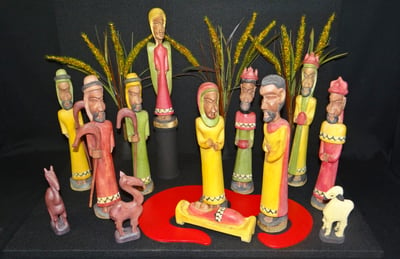
Editorial Note: This series features Nativity sets from Africa on display in the McGrath Institute for Church Life’s Sixth Annual International Crèche Exhibit.
Although Christmas Day has passed, and the holiday music in stores and the lights on houses have disappeared, we are nevertheless still in the liturgical season of Christmas, which lasts until the Baptism of the Lord. Though the excitement and busy planning for Christmas Day can occupy our minds, making January a welcome relief from the intensity of a holiday season, the Christmas season invites us to ponder how the birth of Christ accompanies us even as we return to a normal rhythm of life.
 Taking Mary as our model, we recall that in Luke’s Gospel, after the visit of the Shepherds, Mary “kept all these things, reflecting on them in her heart” (Luke 2:19). This theme is beautifully expressed in the rich detail of “Pondering Hearts,” by an anonymous artist from Swaziland, which evokes a scene of quiet contemplation. Though the wooden figures in this crèche boast a rich attention to detail in their warm colors and patterns, this scene does not contain the vibrant excitement of other Nativity scenes. Instead, gathered around the manger, each wooden figure pauses before the small cradle in a posture of quiet contemplation. The closed eyes of each figure emphasize the quiet peace, reminding us that, no matter how vibrant the outer coloring, the most important invitation is to welcome Jesus into our hearts.
Taking Mary as our model, we recall that in Luke’s Gospel, after the visit of the Shepherds, Mary “kept all these things, reflecting on them in her heart” (Luke 2:19). This theme is beautifully expressed in the rich detail of “Pondering Hearts,” by an anonymous artist from Swaziland, which evokes a scene of quiet contemplation. Though the wooden figures in this crèche boast a rich attention to detail in their warm colors and patterns, this scene does not contain the vibrant excitement of other Nativity scenes. Instead, gathered around the manger, each wooden figure pauses before the small cradle in a posture of quiet contemplation. The closed eyes of each figure emphasize the quiet peace, reminding us that, no matter how vibrant the outer coloring, the most important invitation is to welcome Jesus into our hearts.
 Indeed, this welcome which we extend to Christ is invited by the very humility of the cradle itself. As the season of Christmas draws to a close, we of course celebrate the feast of the Epiphany, the traditional visit of the magi to the Christ-Child. Yet the rich gifts of the magi do not hide the poverty of the Holy Family, poor and exiled from their home by both the census and the angel’s message directing them to flee to Egypt. Thus, homeless and helpless, the incarnate Son of God relies on the gifts of strangers. In “A Dwelling For God,” a simple ceramic crèche by Cameroon artist Alphonse Yenji, this profound theme finds expression in an unfinished house surrounded by the familiar figures of the Nativity story. The shepherds, magi, and animals all line up to welcome the Child, but it is the unfinished hut that houses the Holy Family which fascinates the eye. Despite the rich gifts in the hands of the visiting magi, we cannot escape the poverty of Christ’s birth—and life—that offers such a poor dwelling for God. In this attention to the poverty of Christ, we are invited to remember that the joy of the Christmas season is only the beginning of Christ’s earthly ministry, only the start of his loving attention to the poor and vulnerable. Will we, too, adore even the poverty of the Christ-Child? As we move through the end of this Christmas season, will we make room within our own hearts to ponder our poor and humble Savior?
Indeed, this welcome which we extend to Christ is invited by the very humility of the cradle itself. As the season of Christmas draws to a close, we of course celebrate the feast of the Epiphany, the traditional visit of the magi to the Christ-Child. Yet the rich gifts of the magi do not hide the poverty of the Holy Family, poor and exiled from their home by both the census and the angel’s message directing them to flee to Egypt. Thus, homeless and helpless, the incarnate Son of God relies on the gifts of strangers. In “A Dwelling For God,” a simple ceramic crèche by Cameroon artist Alphonse Yenji, this profound theme finds expression in an unfinished house surrounded by the familiar figures of the Nativity story. The shepherds, magi, and animals all line up to welcome the Child, but it is the unfinished hut that houses the Holy Family which fascinates the eye. Despite the rich gifts in the hands of the visiting magi, we cannot escape the poverty of Christ’s birth—and life—that offers such a poor dwelling for God. In this attention to the poverty of Christ, we are invited to remember that the joy of the Christmas season is only the beginning of Christ’s earthly ministry, only the start of his loving attention to the poor and vulnerable. Will we, too, adore even the poverty of the Christ-Child? As we move through the end of this Christmas season, will we make room within our own hearts to ponder our poor and humble Savior?
Images courtesy of the Marian Library, University of Dayton.



